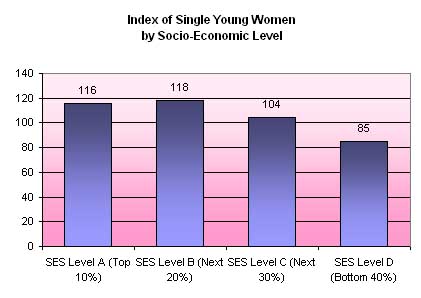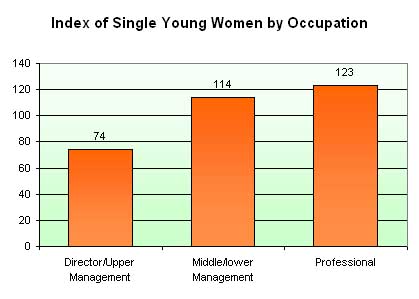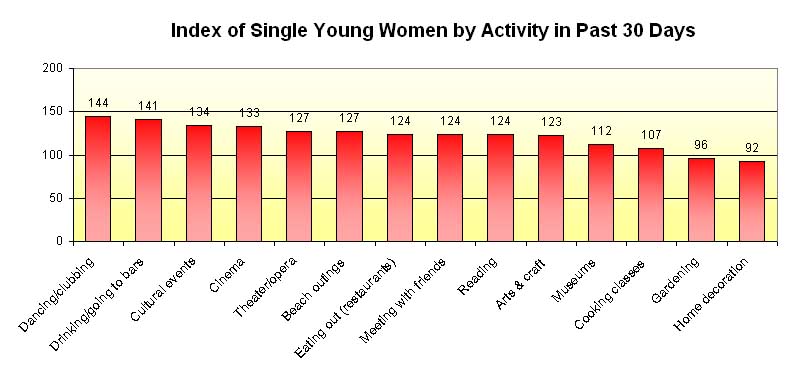
(Source: 2003 TGI Latina)
Single Young Latin American Women
If you were to type in the words "single young Latin American women" into any search engine, you will probably get hundreds of thousands of links to marriage brokers. But that is not the subject of this article. Rather, it is our intention to examine the social aspects of singlehood among young Latin American women. There are a number of popular myths about this group.
As with so many things in Latin America, singlehood has been hypothesized to be related to socio-economic level. Why does a woman stay single? The average Latin American household has about five persons per household. Unless a young girl is economically active, she is using up the limited resources. Thus the hypothesis is that young women in lower socio-economic levels are more likley to get married very young to relieve economic pressures. Conversely, young women in higher socio-economic levels are can afford to remain single far longer.
We will refer to some survey data from the 2003 TGI Latina study. Within this study, there are 8,586 women 18-34 of which 3,561 are single (never married). In the following chart, we have expressed our numbers in terms of indices. For example, within the total sample of women 18-34, 9.1% are in SES Level A. Within single women 18-34, 10.6% are in SES Level A. The index is defined as 100 x 10.6 / 9.1 = 116. Thus, an index of 100 means that the incidence is the same; an index of over 100 means that there are more within the single young women and an index of less than 100 means that there are less within the single young women. This chart confirms that singlehood is higher in the upper socio-economic levels and less likely in the lowest socio-economic level.

(Source: 2003 TGI Latina)
A related hypothesis pertains to employment. Again, a woman who is productively employed is more likely to be able to stay single. Indeed, the index for full-time employment is 116. Thus, employed women are more likely to be single.
The next hypothesis relates to the kinds of jobs that are open to single women. The stereotypical image is that a single woman has to be strong, self-confident and competent. According to the following chart, single women are more likely to occupy the middle/lower management and professional ranks. However, there is still a great barrier for single women to become senior management. Within young women, there is a glass ceiling effect.

(Source: 2003 TGI Latina)
Our next hypothesis pertains to this question: "Do single women have more fun than married women?" That surely must depend on the definition of 'fun'. Looking at the next chart which is about various leisure activities, --- if you want to define 'fun' as going out for some dancing at clubs or drinking in bars,, then single women get much more.

(Source: 2003 TGI Latina)
Clearly, life cannot be solely about going to clubs or getting intoxicated. So the critical question ought to something like, "Are single women happy about their situation?" The following chart shows their responses to a number of attitudinal statements. There is a great deal of sociological and psychological theory behind --- single women resent being confined to household (see Machismo in Latin America), they don't like housework and they don't think greatly of spending time with the family. That may explain why they prefer to stay single, and yet there is still an undercurrent of anxiety about the solo life.

(Source: 2003 TGI Latina)
(posted by Roland Soong, 5/23/2004)
(Return to Zona Latina's Home Page)